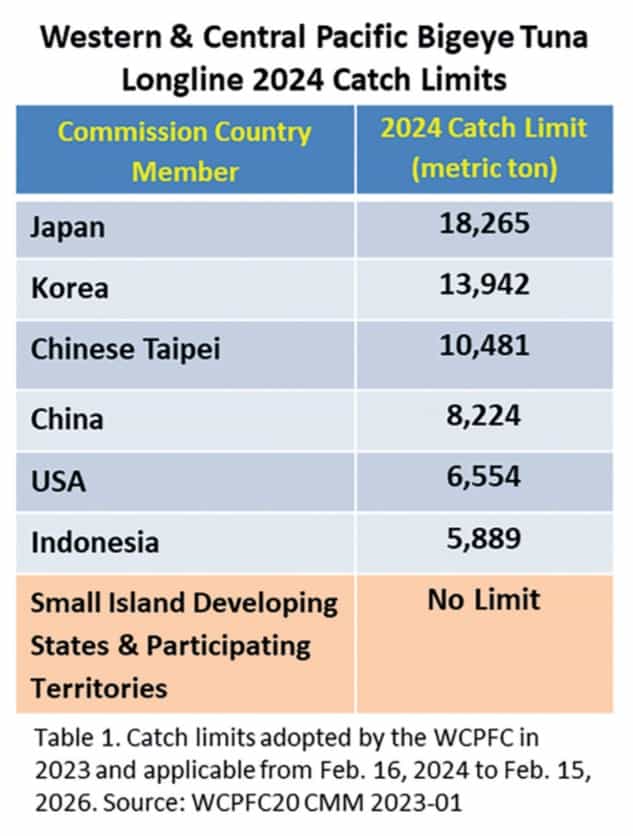The 20th Regular Session of the Western and Central Pacific Fisheries Commission (WCPFC) was held December 4-8, 2023, in Rarotonga, Cook Islands. The primary focus at this meeting was revising the conservation and management measure (CMM) for tropical tuna. For the Western Pacific Regional Fishery Management Council (Council), the two major objectives were for the WCPFC to 1) increase the bigeye tuna catch limit for the Hawai‘i-based U.S. longline fishery; and 2) obtain recognition for American Samoa purse seine vessels to enjoy privileges entitled to Small Island Developing States and Participating Territories.
The first objective was achieved as the catch limit for the Hawai‘i-based longline fishery increased from 3,554 to 6,554 metric tons. This expansion factored in catch previously authorized through arrangements transferring up to 3,000 metric tons in bigeye catch from the U.S. Participating Territories to U.S. longline vessels. Catch limit increases for other nations (see Table 1) are conditional based on increasing observer coverage from a minimum of 5%, with a proportional increase in catch up to 10%. The United States is exempt from these observer coverage requirements because the U.S. fishery already has the highest longline vessel observer coverage and is recognized as the ‘gold standard’ for monitoring within the international fishing community.
However, the second objective proved elusive for American Samoa, as the Commission did not adopt a footnote recognizing U.S.-flagged purse seine tuna vessels as ‘integral to the American Samoa economy.’ This recognition would treat these vessels that offload and home port in American Samoa as associated with the Participating Territory, and therefore exempt from restrictions using fish aggregating devices (FADs). Purse seine vessels are more efficient using FADs and are restricted seasonally during closures on the high seas and inside economic exclusive zones (EEZs) of Pacific Island nations. The critical link lies in the seasonal closures affecting purse seine vessels, prompting them to either offload in American Samoa or shift to the eastern Pacific during closure periods. The latter would result in offloading in the Americas (e.g., Ecuador or Mexico), threatening the vital flow of fish sustaining the cannery in Pago Pago, and the local fishing economy.
The tuna industry represents more than 80% of private employment in American Samoa. Almost 85% of the purse seine vessels offloading in American Samoa are from U.S.-flagged vessels, and a reduction in the size of the U.S. fleet in recent years (40 vessels in 2015 to 12 vessels in 2022) has resulted in a significant decline in landings to the cannery. So any WCPFC provisions to incentivize and maintain supply of tuna to Pago Pago are imperative for the survival of the industry.
The new CMM included reduced FAD closure periods for purse seine vessels from three months in EEZs of Pacific nations to 1.5 months and to 2.5 months on the high seas. Purse seine effort limits in zone and on the high seas for the United States remain unchanged at 1,828 days. Perhaps the reduction in FAD closures will incentivize vessels to remain in the WCPFC area year-round.
American Samoa remains hopeful that a proposed Marine National Sanctuary by the Biden Administration around the Pacific Remote Islands (PRI) will not prohibit commercial tuna fishing. The proposed sanctuary overlays U.S. EEZ waters responsible for 10% of U.S. purse seine catch offloaded to American Samoa. Most U.S. waters are already closed due to the existing PRI Marine National Monument. The Council, at its December 2023 meeting, asserted that the Council’s existing fishing regulations under the Magnuson-Stevens Act for this area have established comprehensive protection since the 1980s. The regulations continue to provide long-lasting conservation and management for the PRI fishery ecosystem, habitat and resources. American Samoa needs to maintain access to U.S. waters for its local purse seine fishery and needs recognition for the remaining 12 vessels to be exempt from seasonal FAD closures.

